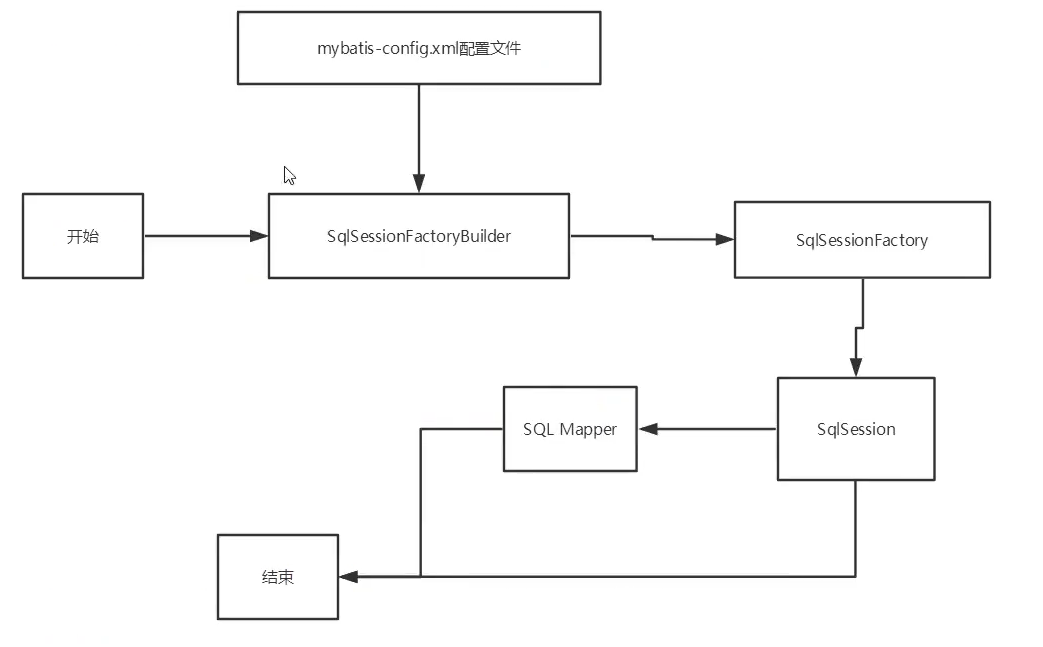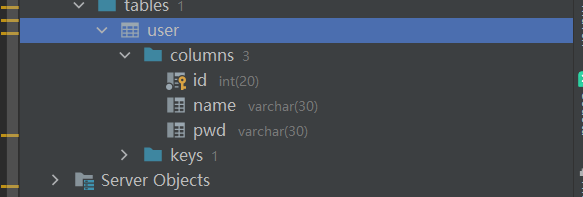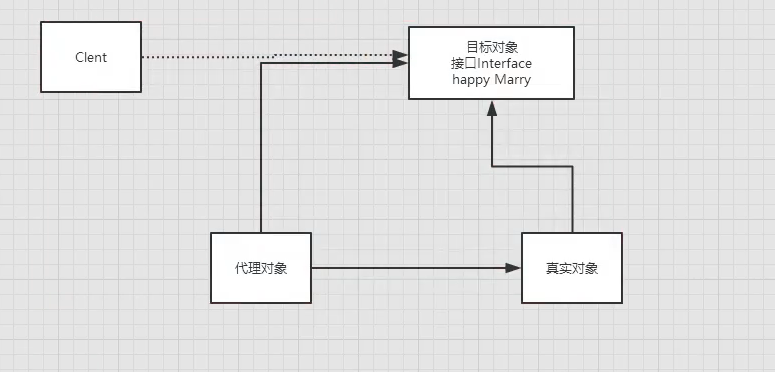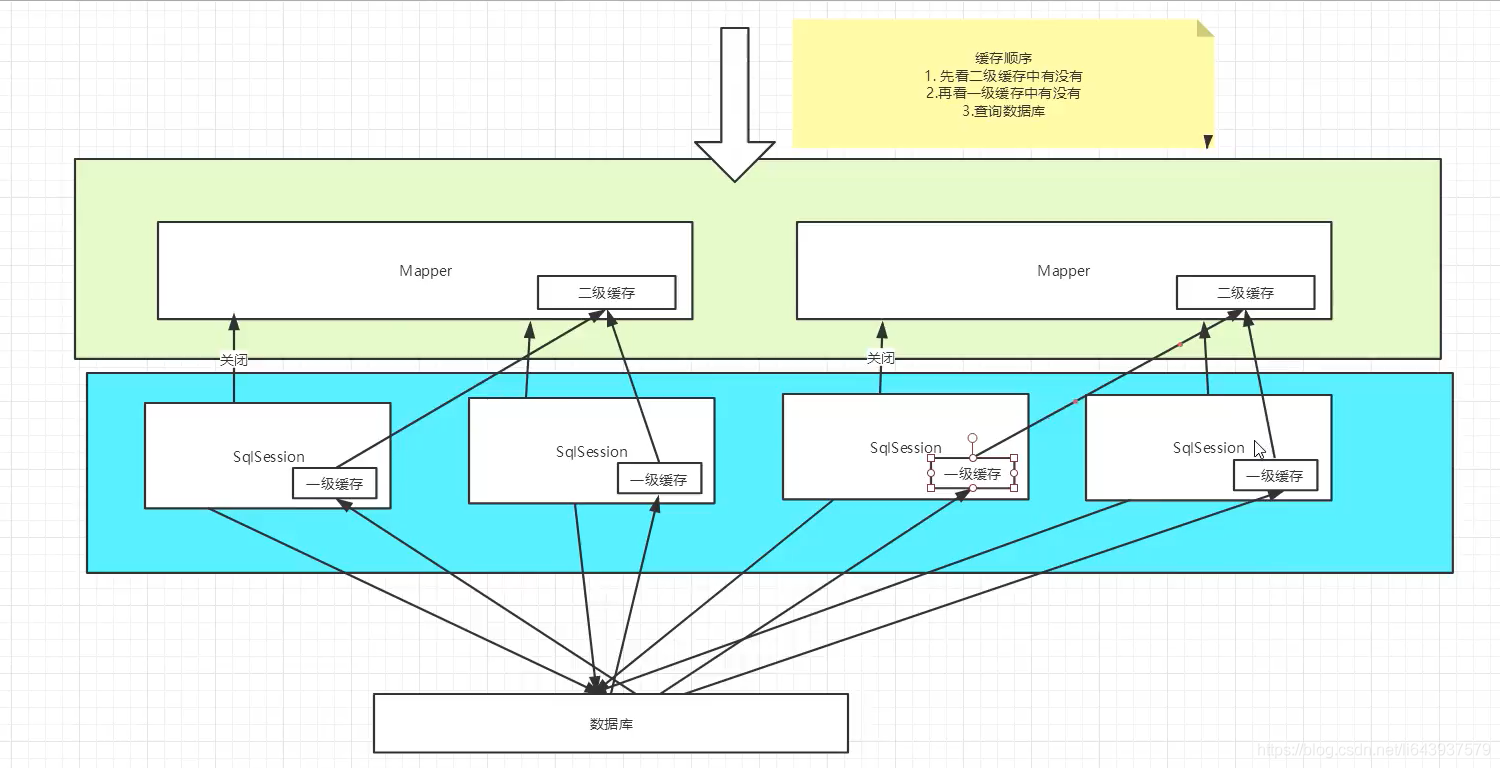Mybatis.md 54 KB
[TOC]
Mybatis
环境:
- JDK1.8
- Mysql5.7
- maven3.6.1
- IDEA
1、简介
1.1、什么是mybatis
- MyBatis 是一款优秀的持久层框架;
- 它支持自定义 SQL、存储过程以及高级映射。MyBatis 免除了几乎所有的 JDBC 代码以及设置参数和获取结果集的工作。MyBatis 可以通过简单的 XML 或注解来配置和映射原始类型、接口和 Java POJO(Plain Old Java Objects,普通老式 Java 对象)为数据库中的记录。
如何获得Mybatis
<!-- https://mvnrepository.com/artifact/org.mybatis/mybatis --> <dependency> <groupId>org.mybatis</groupId> <artifactId>mybatis</artifactId> <version>3.5.6</version> </dependency>1.2、持久化
数据持久化
- 持久化就是将程序的数据在持久状态和瞬时状态转化的过程
- 内存:断电即失
- 数据库(JDBC),io文件持久化
- 生活方面的例子:冷藏,罐头
为什么需要持久化
- 不想丢掉一些对象
- 内存太贵
1.3、持久层
Dao层,Service层,Controller层
- 完成持久化工作的代码块
- 层界限十分明显
1.4、为什么需要Mybatis
- 帮助程序员将数据存入到数据库中
- 方便
- 传统的JDBC代码太复杂,简化->框架->自动化
- 不用Mybatis也可以。更容易上手。技术没有高低之分
- 优点:
- 简单易学:本身就很小且简单。没有任何第三方依赖,最简单安装只要两个jar文件+配置几个sql映射文件就可以了,易于学习,易于使用,通过文档和源代码,可以比较完全的掌握它的设计思路和实现。
- 灵活:mybatis不会对应用程序或者数据库的现有设计强加任何影响。sql写在xml里,便于统一管理和优化。通过sql语句可以满足操作数据库的所有需求。
- 解除sql与程序代码的耦合:通过提供DAO层,将业务逻辑和数据访问逻辑分离,使系统的设计更清晰,更易维护,更易单元测试。sql和代码的分离,提高了可维护性。
- 提供xml标签,支持编写动态sql。
- 最重要的一点,使用的人多!公司需要!
2、第一个Mybatis程序
思路流程:搭建环境-->导入Mybatis--->编写代码--->测试
2.1、搭建环境
搭建数据库
CREATE DATABASE `mybatis`; USE `mybatis`; DROP TABLE IF EXISTS `user`; CREATE TABLE `user` ( `id` int(20) NOT NULL, `name` varchar(30) DEFAULT NULL, `pwd` varchar(30) DEFAULT NULL, PRIMARY KEY (`id`) ) ENGINE=InnoDB DEFAULT CHARSET=utf8; insert into `user`(`id`,`name`,`pwd`) values (1,'狂神','123456'),(2,'张三','abcdef'),(3,'李四','987654');
新建项目
- 新建一个普通maven项目
- 删除src目录
- 导入maven依赖
<!--导入依赖-->
<dependencies>
<!--mysql-->
<dependency>
<groupId>mysql</groupId>
<artifactId>mysql-connector-java</artifactId>
<version>8.0.22</version>
</dependency>
<!--mybatis-->
<dependency>
<groupId>org.mybatis</groupId>
<artifactId>mybatis</artifactId>
<version>3.5.6</version>
</dependency>
<!--junit-->
<dependency>
<groupId>junit</groupId>
<artifactId>junit</artifactId>
<version>4.12</version>
</dependency>
</dependencies>
2.2、创建一个模块
编写MyBatis核心配置文件 查看帮助文档
<?xml version="1.0" encoding="UTF-8" ?>
<!DOCTYPE configuration
PUBLIC "-//mybatis.org//DTD Config 3.0//EN"
"http://mybatis.org/dtd/mybatis-3-config.dtd">
<configuration>
<environments default="development">
<environment id="development">
<transactionManager type="JDBC"/>
<dataSource type="POOLED">
<property name="driver" value="com.mysql.cj.jdbc.Driver"/>
<property name="url"
value="jdbc:mysql://124.221.127.83:3306/mybatis?useSSL=true&useUnicode=true&characterEncoding=utf8"/>
<property name="username" value="root"/>
<property name="password" value="root"/>
</dataSource>
</environment>
</environments>
<mappers>
<mapper resource="com/dao/UserMapper.xml"/>
</mappers>
</configuration>
编写mybatis工具类
public class MybatisUtils {
private static SqlSessionFactory sqlSessionFactory;
static {
try {
// 使用mybatis工具类获取sqlSessionFactory对象
String resource = "mybatis-config.xml";
InputStream inputStream = Resources.getResourceAsStream(resource);
sqlSessionFactory = new SqlSessionFactoryBuilder().build(inputStream);
} catch (IOException e) {
e.printStackTrace();
}
}
// 既然有了SqlSessionFactory,顾名思义,我们可以从中获得SqlSession的实例。
// SqlSession 提供了在数据库执行 SQL 命令所需的所有方法。你可以通过 SqlSession 实例来直接执行已映射的 SQL 语句。
public static SqlSession getSqlSession() {
return sqlSessionFactory.openSession();
}
}
2.3、编写代码
- 实体类
public class User {
private int id;
private String name;
private String pwd;
public User() {
}
public User(int id, String name, String pwd) {
this.id = id;
this.name = name;
this.pwd = pwd;
}
public int getId() {
return id;
}
public void setId(int id) {
this.id = id;
}
public String getName() {
return name;
}
public void setName(String name) {
this.name = name;
}
public String getPwd() {
return pwd;
}
public void setPwd(String pwd) {
this.pwd = pwd;
}
@Override
public String toString() {
return "User{" +
"id=" + id +
", name='" + name + '\'' +
", pwd='" + pwd + '\'' +
'}';
}
}
- Dao接口
public interface UseMapper {
// 获取全部用户
List<User> getUserList();
// 根据ID查询用户
User getUserById(int id);
// 添加一个用户
int addUser(User user);
// 修改一个用户
int updateUser(User user);
// 根据id删除用户
int deleteUser(int id);
}
- mapper
<?xml version="1.0" encoding="UTF-8" ?>
<!DOCTYPE mapper
PUBLIC "-//mybatis.org//DTD Mapper 3.0//EN"
"http://mybatis.org/dtd/mybatis-3-mapper.dtd">
<!--namespace=绑定一个对应的Dao/Mapper窗口-->
<mapper namespace="com.dao.UseMapper">
<!--select查询语句-->
<select id="getUserList" resultType="com.entity.User">
select *
from user
</select>
<select id="getUserById" parameterType="int" resultType="com.entity.User">
select * from user where id = #{id}
</select>
<!--对象中的属性可以直接提取出来-->
<insert id="addUser" parameterType="com.entity.User">
insert into user (id,name,pwd) values (#{id},#{name},#{pwd})
</insert>
<update id="updateUser" parameterType="com.entity.User">
update user set name=#{name},pwd=#{pwd} where id = #{id}
</update>
<delete id="deleteUser" parameterType="int">
delete from user where id = #{id}
</delete>
</mapper>
3、万能的Map
假设,我们的实体类,或者数据库中的表,字段或者参数过多,我们应当考虑使用Map!
// 万能的Map
int addUser2(Map<String,Object> map);
<insert id="addUser2" parameterType="map">
insert into user (id,pwd) values (#{userid},#{password})
</insert>
Map传递参数,直接在sql中取出key即可! 对象传递参数,直接在sql中取对象的属性即可! 只有一个基本类型参数的情况下,可以直接在sql中取到! 多个参数用Map,或者注解!
在sql语句中拼接通配符,会引起sql注入
<select id="getUserLike" resultType="com.entity.User">
select * from user where name like "%"#{value}"%"
</select>
4、配置解析
4.1、核心配置文件
- mybatis-config.xml
Mybatis的配置文件包含了会深深影响MyBatis行为的设置和属性信息。
configuration(配置) properties(属性) settings(设置) typeAliases(类型别名) typeHandlers(类型处理器) objectFactory(对象工厂) plugins(插件) environments(环境配置) environment(环境变量) transactionManager(事务管理器) dataSource(数据源) databaseIdProvider(数据库厂商标识) mappers(映射器)
4.2、环境变量
MyBatis 可以配置成适应多种环境
不过要记住:尽管可以配置多个环境,但每个 SqlSessionFactory 实例只能选择一种环境。
Mybatis 默认的事务管理器是JDBC,连接池:POOLED
4.3、属性
我们可以通过properties属性来引用配置文件
这些属性可以在外部进行配置,并可以进行动态替换。你既可以在典型的 Java 属性文件中配置这些属性,也可以在 properties 元素的子元素中设置。 (db.properties)
编写一个配置文件
driver=com.mysql.cj.jdbc.Driver
url=jdbc:mysql://124.221.127.83:3306/mybatis?useSSL=true&useUnicode=true&characterEncoding=utf8
username=root
password=root
在核心配置文件中引入
mybatis-config.xml (同时有的话,外面properties优先)
<?xml version="1.0" encoding="UTF-8" ?>
<!DOCTYPE configuration
PUBLIC "-//mybatis.org//DTD Config 3.0//EN"
"http://mybatis.org/dtd/mybatis-3-config.dtd">
<configuration>
<!--引入外部配置文件-->
<properties resource="db.properties">
<property name="username" value="root"/>
<property name="password" value="root"/>
</properties>
<environments default="development">
<environment id="development">
<transactionManager type="JDBC"/>
<dataSource type="POOLED">
<property name="driver" value="${driver}"/>
<property name="url" value="${url}"/>
<property name="username" value="${username}"/>
<property name="password" value="${password}"/>
</dataSource>
</environment>
</environments>
<mappers>
<mapper resource="com/dao/UserMapper.xml"/>
</mappers>
</configuration>
4.4、类型别名 typeAliases
- 类型别名可为 Java 类型设置一个缩写名字。 它仅用于 XML 配置.
- 意在降低冗余的全限定类名书写。
<!--可以给实体类起别名-->
<typeAliases>
<typeAlias type="com.entity.User" alias="User"/>
</typeAliases>
也可以指定一个包,每一个在包 domain.blog 中的 Java Bean,在没有注解的情况下,会使用 Bean 的首字母小写的非限定类名来作为它的别名。 比如 domain.blog.Author 的别名为 author
在实体类比较少的时候,使用第一种方式。
如果实体类十分多,建议用第二种扫描包的方式。第一种可以DIY别名,第二种不行,如果非要改,需要在实体上增加注解。
@Alias("user")
public class User {
...
}
4.5、设置
| 设置名 | 描述 | 有效值 | 默认 |
|---|---|---|---|
| cacheEnabled | 全局性地开启或关闭所有映射器配置文件中已配置的任何缓存。 | true | false | true |
| lazyLoadingEnabled | 延迟加载的全局开关。当开启时,所有关联对象都会延迟加载。 特定关联关系中可通过设置 fetchType 属性来覆盖该项的开关状态。 |
true | false | false |
| logImpl | 指定 MyBatis 所用日志的具体实现,未指定时将自动查找。 | SLF4J | LOG4J | LOG4J2 | JDK_LOGGING | COMMONS_LOGGING | STDOUT_LOGGING | NO_LOGGING | 未设置 |
4.6、映射器
MapperRegistry:注册绑定我们的Mapper文件;
方式一: [推荐使用]
<mappers>
<mapper resource="com/dao/UserMapper.xml"/>
</mappers>
方式二:
<mappers>
<mapper class="com.dao.UserMapper"/>
</mappers>
- 接口和它的Mapper必须同名
- 接口和他的Mapper必须在同一包下
方式三:
<mappers>
<package name="com.dao" />
</mappers>
- 接口和它的Mapper必须同名
- 接口和他的Mapper必须在同一包下
4.7、作用域和生命周期
生命周期和作用域是至关重要的,因为错误的使用会导致非常严重的并发问题
SqlSessionFactoryBuilder:
- 一旦创建了SqlSessionFactory,就不再需要它了
- 局部变量
SqlSessionFactory:
- 就是数据库连接池。
- 一旦被创建就应该在应用的运行期间一直存在 ,没有任何理由丢弃它或重新创建另一个实例 。 多次重建 SqlSessionFactory 被视为一种代码“坏习惯”。
- 因此 SqlSessionFactory 的最佳作用域是应用作用域。
- 最简单的就是使用单例模式或者静态单例模式。
SqlSession:
- 每个线程都应该有它自己的 SqlSession 实例。
- 连接到连接池的请求!
- SqlSession 的实例不是线程安全的,因此是不能被共享的 ,所以它的最佳的作用域是请求或方法作用域。
- 用完之后赶紧关闭,否则资源被占用。
这里面的每一个Mapper就代表每一个具体业务!
5、解决属性名和字段名不一致的问题
数据库中的字段
新建一个项目,拷贝之前,测试实体字段不一致的情况 User
public class User {
private int id;
private String name;
private String password;
}
解决方法: 核心配置文件
- 起别名
<select id="getUserById" parameterType="int" resultType="com.entity.User">
select id, name, pwd as password from user where id = #{id}
</select>
- resultMap 结果集映射
<select id="getUserById" resultMap="UserMap" parameterType="int">
select * from user where id = #{id}
</select>
<!--结果集映射-->
<resultMap id="UserMap" type="User">
<!--column 数据库中的字段,property实体中的属性-->
<result column="id" property="id"></result>
<result column="name" property="name"></result>
<result column="pwd" property="password"></result>
</resultMap>
resultMap元素是 MyBatis 中最重要最强大的元素。- ResultMap 的设计思想是,对简单的语句做到零配置,对于复杂一点的语句,只需要描述语句之间的关系就行了。
<!--结果集映射-->
<resultMap id="UserMap" type="User">
<!--column 数据库中的字段,property实体中的属性-->
<result column="pwd" property="password"></result>
</resultMap>
- resultMap 元素是 MyBatis 中最重要最强大的元素。
- ResultMap 的设计思想是,对简单的语句做到零配置,对于复杂一点的语句,只需要描述语句之间的关系就行了。
- ResultMap 的优秀之处——你完全可以不用显式地配置它们。
- 如果这个世界总是这么简单就好了。
6、日志
6.1、日志工厂
如果一个数据库操作出现了异常,我们需要排错。日志就是最好的助手。 曾经:sout,debug 现在:日志工厂
- SLF4J
- LOG4J [掌握]
- LOG4J2
- JDK_LOGGING
- COMMONS_LOGGING
- STDOUT_LOGGING [掌握]
- NO_LOGGING
具体使用哪一个,在设置中设定 STDOUT_LOGGING 标志日志输出 mybatis-confi中
<settings>
<setting name="logImpl" value="STDOUT_LOGGING"/>
</settings>
6.2、Log4j
- 先导包
<!--log4j-->
<dependency>
<groupId>log4j</groupId>
<artifactId>log4j</artifactId>
<version>1.2.17</version>
</dependency>
- 新建log4j.properties文件
### set log levels ###
log4j.rootLogger = DEBUG,console,file
### 输出到控制台 ###
log4j.appender.console = org.apache.log4j.ConsoleAppender
log4j.appender.console.Target = System.out
log4j.appender.console.Threshold = DEBUG
log4j.appender.console.layout = org.apache.log4j.PatternLayout
log4j.appender.console.layout.ConversionPattern = [%c]-%m%n
### 输出到日志文件 ###
log4j.appender.file=org.apache.log4j.RollingFileAppender
log4j.appender.file.File=./log/hou.log
log4j.appender.file.MaxFileSize=10mb
log4j.appender.file.Threshold=DEBUG
log4j.appender.file.layout=org.apache.log4j.PatternLayout
log4j.appender.file.layout.ConversionPattern=[%p][%d{yy-MM-dd}][%c]%m%n
# 日志输出级别
log4j.logger.org.mybatis=DEBUG
log4j.logger.java.sql=DEBUG
log4j.logger.java.sql.Statement=DEBUG
log4j.logger.java.sql.ResultSet=DEBUG
log4j.logger.java.sql.PreparedStatement=DEBUG
- 配置实现
<settings>
<setting name="logImpl" value="LOG4J"/>
</settings>
- log4j的使用
6.3、log4j简单使用
- 在要使用Log4j的类中,导入包 import org.apache.log4j.Logger;
- 日志对象,参数为当前类的class对象
Logger logger = Logger.getLogger(UserDaoTest.class);
- 日志级别
logger.info("info: 测试log4j");
logger.debug("debug: 测试log4j");
logger.error("error:测试log4j");
7、分页
思考:为什么分页?
- 减少数据的处理量
7.1、使用limit分页
SELECT * FROM user LIMIT startIndex,pageSize;
SELECT * FROM user LIMIT end; #[0, end]
使用MyBatis实现分页,核心SQL
- 接口
// 分页
List<User> getUserByLimit(Map<String,Integer> map);
- Mapper.xml
<!--分页查询-->
<select id="getUserByLimit" parameterType="map" resultMap="UserMap">
select * from user limit #{startIndex},#{pageSize}
</select>
- 测试
@Test
public void getUserByLimit(){
SqlSession sqlSession = MybatisUtils.getSqlSession();
UserMapper mapper = sqlSession.getMapper(UserMapper.class);
Map<String, Integer> map = new HashMap<String, Integer>();
map.put("startIndex", 1);
map.put("pageSize", 2);
List<User> userList = mapper.getUserByLimit(map);
for(User user:userList){
System.out.println(user);
}
sqlSession.close();
}
7.2、使用RowBounds分页
不再使用SQL实现分页
- 接口
//分页2
List<User> getUserByRowBounds();
- mapper.xml
<!--分页查询2-->
<select id="getUserByRowBounds">
select * from user limit #{startIndex},#{pageSize}
</select>
- 测试
@Test
public void getUserByRow(){
SqlSession sqlSession = MybatisUtils.getSqlSession();
// RowBounds实现
RowBounds rowBounds = new RowBounds(1, 2);
// 通过java代码层面
List<User> userList = sqlSession.selectList
("com.dao.UserMapper.getUserByRowBounds",
null,rowBounds);
for (User user : userList) {
System.out.println(user);
}
sqlSession.close();
}
7.3、分页插件
8、使用注解开发
8.1、面向接口编程
三个面向区别
- 面向对象是指,我们考虑问题时,以对象为单位,考虑它的属性和方法
- 面向过程是指,我们考虑问题时,以一个具体的流程(事务过程)为单位,考虑它的实现;
- 接口设计与非接口设计是针对复用技术而言的,与面向对象(过程)不是一个问题,更多的体现就是对系统整体的架构;
8.2、使用注解开发
删除 UserMapper.xml
UserMapper
public interface UserMapper {
@Select("select * from user")
List<User> getUsers();
}
- 核心配置 mybatis-config.xml
<!--绑定接口-->
<mappers>
<mapper class="com.hou.dao.UserMapper"></mapper>
</mappers>
本质:反射机制
底层:动态代理
Mybatis详细执行流程:
- Resource获取全局配置文件
- 实例化SqlsessionFactoryBuilder
- 解析配置文件流XMLCondigBuilder
- Configration所有的配置信息
- SqlSessionFactory实例化
- trasactional事务管理
- 创建executor执行器
- 创建SqlSession
- 实现CRUD
- 查看是否执行成功
- 提交事务
- 关闭
8.3、注解CRUD
编写接口
public interface UserMapper {
// 获取全部用户
@Select("select * from user")
List<User> getUserList();
// 方法存在多个参数,所有的参数必须加@Param
@Select("select * from user where id = #{id}")
User getUserById(@Param("id") int id);
@Insert("insert into user (id, name, pwd) values" +
"(#{id},#{name},#{pwd})")
int addUser(User user);
@Update("update user set name=#{name}, pwd=#{pwd} " +
"where id=#{id}")
int updateUser(User user);
@Delete("delete from user where id=#{id}")
int deleteUser(@Param("id") int id);
}
MybatisUtile
public class MybatisUtils {
private static SqlSessionFactory sqlSessionFactory;
static {
try {
// 使用mybatis工具类获取sqlSessionFactory对象
String resource = "mybatis-config.xml";
InputStream inputStream = Resources.getResourceAsStream(resource);
sqlSessionFactory = new SqlSessionFactoryBuilder().build(inputStream);
} catch (IOException e) {
e.printStackTrace();
}
}
// 既然有了SqlSessionFactory,顾名思义,我们可以从中获得SqlSession的实例。
// SqlSession 提供了在数据库执行 SQL 命令所需的所有方法。你可以通过 SqlSession 实例来直接执行已映射的 SQL 语句。
public static SqlSession getSqlSession() {
return sqlSessionFactory.openSession(true);
}
}
Test 【注意:我们必须要将接口注册绑定到我们的核心配置文件中】
public class UserMapperTest {
@Test
public void getUserById(){
// 获得sqlSession对象
SqlSession sqlSession = MybatisUtils.getSqlSession();
try{
// 1.执行 getMapper
UserMapper userDao = sqlSession.getMapper(UserMapper.class);
User user = userDao.getUserById(1);
System.out.println(user);
}catch(Exception e){
e.printStackTrace();
}finally{
// 关闭
sqlSession.close();
}
}
@Test
public void addUser(){
// 获得sqlSession对象
SqlSession sqlSession = MybatisUtils.getSqlSession();
try{
// 1.执行 getMapper
UserMapper userDao = sqlSession.getMapper(UserMapper.class);
userDao.addUser(new User(6, "kun","123"));
}catch(Exception e){
e.printStackTrace();
}finally{
// 关闭
sqlSession.close();
}
}
@Test
public void updateUser(){
// 获得sqlSession对象
SqlSession sqlSession = MybatisUtils.getSqlSession();
try{
// 1.执行 getMapper
UserMapper userDao = sqlSession.getMapper(UserMapper.class);
userDao.updateUser(new User(6, "fang","123"));
}catch(Exception e){
e.printStackTrace();
}finally{
//关闭
sqlSession.close();
}
}
@Test
public void deleteUser(){
// 获得sqlSession对象
SqlSession sqlSession = MybatisUtils.getSqlSession();
try{
// 1.执行 getMapper
UserMapper userDao = sqlSession.getMapper(UserMapper.class);
userDao.deleteUser(6);
}catch(Exception e){
e.printStackTrace();
}finally{
//关闭
sqlSession.close();
}
}
}
关于@Param( )注解
- 基本类型的参数或者String类型,需要加上
- 引用类型不需要加
- 如果只有一个基本类型的话,可以忽略,但是建议大家都加上
- 我们在SQL中引用的就是我们这里的@Param()中设定的属性名
#{} 和 ${}
- 一般使用#号,防止注入
- 两个都可以使用
9、Lombok
Lombok项目是一个Java库,它会自动插入编辑器和构建工具中,Lombok提供了一组有用的注释,用来消除Java类中的大量样板代码。仅五个字符(@Data)就可以替换数百行代码从而产生干净,简洁且易于维护的Java类。
使用步骤:
在IDEA中安装Lombok插件,现在已经不需要安装,idea已经内置
在项目中导入Lombok的jar包
<dependency>
<groupId>org.projectlombok</groupId>
<artifactId>lombok</artifactId>
<version>1.18.8</version>
</dependency>
- 在程序上加注解
在实体类上加注解
@AllArgsConstructor // 有参构造
@NoArgsConstructor // 无参构造
@Data // 无参构造,get,set,toString,hashCode
public class User {
private int id;
private String name;
private String pwd;
}
10、多对一处理
多对一:
- 多个学生,对应一个老师
- 对于学生而言,关联–多个学生,关联一个老师【多对一】
- 对于老师而言,集合–一个老师,有很多个学生【一对多】
SQL语句:
CREATE TABLE `teacher` (
`id` INT(10) NOT NULL,
`name` VARCHAR(30) DEFAULT NULL,
PRIMARY KEY (`id`)
)ENGINE = INNODB DEFAULT CHARSET=utf8
INSERT INTO teacher(`id`,`name`) VALUES (1,'秦老师');
CREATE TABLE `student` (
`id` INT(10) NOT NULL,
`name` VARCHAR(30) DEFAULT NULL,
`tid` INT(10) DEFAULT NULL,
PRIMARY KEY (`id`),
KEY `fktid`(`tid`),
CONSTRAINT `fktid` FOREIGN KEY (`tid`) REFERENCES `teacher` (`id`)
)ENGINE = INNODB DEFAULT CHARSET=utf8
INSERT INTO `student`(`id`,`name`,`tid`) VALUES ('1','小明','1');
INSERT INTO `student`(`id`,`name`,`tid`) VALUES ('2','小红','1');
INSERT INTO `student`(`id`,`name`,`tid`) VALUES ('3','小张','1');
INSERT INTO `student`(`id`,`name`,`tid`) VALUES ('4','小李','1');
INSERT INTO `student`(`id`,`name`,`tid`) VALUES ('5','小王','1');
测试环境搭建
- 导入lombok
- 新建实体类Teacher,Student
- 建立Mapper接口
- 建立Mapper.xml文件
- 在核心配置文件中绑定注册我们的Mapper接口或者文件 【方式很多,随心选】
- 测试查询是否能够成功
10.1、按照查询嵌套处理
- 给StudentMapper接口增加方法
// 获取所有学生及对应老师的信息
public List<Student> getStudents();
- 编写对应打的Mapper文件
<?xml version="1.0" encoding="UTF-8" ?>
<!DOCTYPE mapper
PUBLIC "-//mybatis.org//DTD Mapper 3.0//EN"
"http://mybatis.org/dtd/mybatis-3-mapper.dtd">
<mapper namespace="com.kuang.dao.StudentMapper">
<!--
需求:获取所有学生及对应老师的信息
思路:
1. 获取所有学生的信息
2. 根据获取的学生信息的老师ID->获取该老师的信息
3. 思考问题,这样学生的结果集中应该包含老师,该如何处理呢,数据库中我们一般使用关联查询?
1. 做一个结果集映射:StudentTeacher
2. StudentTeacher结果集的类型为 Student
3. 学生中老师的属性为teacher,对应数据库中为tid。
多个 [1,...)学生关联一个老师=> 一对一,一对多
4. 查看官网找到:association – 一个复杂类型的关联;使用它来处理关联查询
-->
<select id="getStudents" resultMap="StudentTeacher">
select * from student
</select>
<resultMap id="StudentTeacher" type="Student">
<!--association关联属性 property属性名 javaType属性类型 column在多的一方的表中的列名-->
<association property="teacher" column="tid" javaType="Teacher" select="getTeacher"/>
</resultMap>
<!--
这里传递过来的id,只有一个属性的时候,下面可以写任何值
association中column多参数配置:
column="{key=value,key=value}"
其实就是键值对的形式,key是传给下个sql的取值名称,value是片段一中sql查询的字段名。
-->
<select id="getTeacher" resultType="teacher">
select * from teacher where id = #{id}
</select>
</mapper>
编写完毕去Mybatis配置文件中,注册Mapper!
注意点说明:
<resultMap id="StudentTeacher" type="Student">
<!--association关联属性 property属性名 javaType属性类型 column在多的一方的表中的列名-->
<association property="teacher" column="{id=tid,name=tid}" javaType="Teacher" select="getTeacher"/>
</resultMap>
<!--
这里传递过来的id,只有一个属性的时候,下面可以写任何值
association中column多参数配置:
column="{key=value,key=value}"
其实就是键值对的形式,key是传给下个sql的取值名称,value是片段一中sql查询的字段名。
-->
<select id="getTeacher" resultType="teacher">
select * from teacher where id = #{id} and name = #{name}
</select>
- 测试
@Test
public void testGetStudents(){
SqlSession session = MybatisUtils.getSession();
StudentMapper mapper = session.getMapper(StudentMapper.class);
List<Student> students = mapper.getStudents();
for (Student student : students){
System.out.println(
"学生名:"+ student.getName()
+"\t老师:"+student.getTeacher().getName());
}
}
10.2、按照结果嵌套查询
除了上面这种方式,还有其他思路吗?
我们还可以按照结果进行嵌套处理;
- 接口方法编写
public List<Student> getStudents2();
- 编写对应的mapper文件
<!--
按查询结果嵌套处理
思路:
1. 直接查询出结果,进行结果集的映射
-->
<select id="getStudents2" resultMap="StudentTeacher2">
select s.id sid, s.name sname, t.name tname, t.id tid
from student s,
teacher t
where s.tid = t.id
</select>
<resultMap id="StudentTeacher2" type="Student">
<!--
id是作为唯一标识的,当和其他对象实例对比的时候,
这个id很有用,尤其是应用到缓存和内嵌的结果映射。
result可以有多个,分别对应数据库中的各个字段和实体类中的属性。
-->
<id property="id" column="sid"/>
<result property="name" column="sname"/>
<!--关联对象property 关联对象在Student实体类中的属性-->
<association property="teacher" javaType="Teacher">
<id property="id" column="tid"/>
<result property="name" column="tname"/>
</association>
</resultMap>
- 去mybatis-config文件中注入【此处应该处理过了】
<!--绑定接口-->
<mappers>
<mapper resource="com/dao/TeacherMapper.xml"/>
<mapper resource="com/dao/StudentMapper.xml"/>
</mappers>
- 测试
@Test
public void testGetStudents2() {
SqlSession sqlSession = MybatisUtils.getSqlSession();
StudentMapper mapper = sqlSession.getMapper(StudentMapper.class);
List<Student> students = mapper.getStudents2();
for (Student student : students) {
System.out.println(student);
}
sqlSession.close();
}
小结
- 按照查询进行嵌套处理就像SQL中的子查询
- 按照结果进行嵌套处理就像SQL中的联表查询
回顾Mysql多对一查询方式:
- 子查询
- 联表查询
11、一对多处理
比如:一个老师拥有多个学生! 对于老师而言,就是一对多的关系!
11.1、环境搭建
- 环境搭建,和刚才一样 实体类:
@Data
public class Student {
private int id;
private String name;
private int tid;
}
@Data
public class Teacher {
private int id;
private String name;
// 一个老师拥有多个学生
private List<Student> students;
}
..... 和之前一样,搭建测试的环境!
11.2、按照结果嵌套查询
- TeacherMapper接口编写方法
// 获取指定老师,及老师下的所有学生
Teacher getTeacher(@Param("tid") int id);
- 编写接口对应的Mapper配置文件
<!--
思路:
1. 从学生表和老师表中查出学生id,学生姓名,老师姓名
2. 对查询出来的操作做结果集映射
1. 集合的话,使用collection!
JavaType和ofType都是用来指定对象类型的
JavaType是用来指定entity中属性的类型
ofType-相当于泛型-指定的是映射到list集合属性中entity的类型。
-->
<select id="getTeacher" resultMap="TeacherStudent">
select s.id sid, s.name sname , t.name tname, t.id tid
from student s,teacher t
where s.tid = t.id and t.id=#{tid}
</select>
<resultMap id="TeacherStudent" type="Teacher">
<id property="id" column="tid"/>
<result property="name" column="tname"/>
<collection property="students" ofType="Student">
<result property="id" column="sid" />
<result property="name" column="sname" />
<result property="tid" column="tid" />
</collection>
</resultMap>
- 将Mapper文件注册到MyBatis-config文件中
<!--绑定接口-->
<mappers>
<mapper resource="com/dao/TeacherMapper.xml"/>
<mapper resource="com/dao/StudentMapper.xml"/>
</mappers>
- 测试
@Test
public void test() {
SqlSession sqlSession = MybatisUtils.getSqlSession();
TeacherMapper mapper = sqlSession.getMapper(TeacherMapper.class);
Teacher teacher = mapper.getTeacher(1);
List<Student> students = teacher.getStudents();
for (Student student : students) {
System.out.println(student);
}
sqlSession.close();
}
11.3、按照查询嵌套处理
- TeacherMapper接口编写方法
public Teacher getTeacher2(int id);
- 编写接口对应的Mapper配置文件
<select id="getTeacher2" resultMap="TeacherStudent2">
select * from teacher where id = #{tid}
</select>
<resultMap id="TeacherStudent2" type="Teacher">
<id property="id" column="id"/>
<result property="name" column="name"/>
<!--column是一对多的外键 , 写的是一的主键的列名-->
<collection property="students" ofType="Student" column="id" select="getStudentByTeacherId"/>
</resultMap>
<select id="getStudentByTeacherId" resultType="Student">
select * from student where tid = #{id}
</select>
将Mapper文件注册到MyBatis-config文件中
测试
@Test
public void test() {
SqlSession sqlSession = MybatisUtils.getSqlSession();
TeacherMapper mapper = sqlSession.getMapper(TeacherMapper.class);
Teacher teacher = mapper.getTeacher2(1);
System.out.println(teacher);
sqlSession.close();
}
小结
- 关联-association
- 集合-collection
- 所以association是用于一对一和多对一,而collection是用于一对多的关系
- javaType和ofType都是用来指定对象类型的
- JavaType是用来指定entity中属性的类型
- ofType指定的是映射到list集合属性中entity的类型,泛型的约束类型
注意说明:
- 保证SQL的可读性,尽量通俗易懂
- 根据实际要求,尽量编写性能更高的SQL语句
- 注意属性名和字段不一致的问题
- 注意一对多和多对一 中:字段和属性对应的问题
- 尽量使用Log4j,通过日志来查看自己的错误
面试高频:
- Mysql引擎
- InnoDB底层原理
- 索引
- 索引优化
12、动态SQL
什么是动态SQL:动态SQL指的是根据不同的查询条件 , 生成不同的Sql语句.
官网描述:
MyBatis 的强大特性之一便是它的动态 SQL。如果你有使用 JDBC 或其它类似框架的经验,你就能体会到根据不同条件拼接 SQL 语句的痛苦。例如拼接时要确保不能忘记添加必要的空格,还要注意去掉列表最后一个列名的逗号。利用动态 SQL 这一特性可以彻底摆脱这种痛苦。
虽然在以前使用动态 SQL 并非一件易事,但正是 MyBatis 提供了可以被用在任意 SQL 映射语句中的强大的动态 SQL 语言得以改进这种情形。
动态 SQL 元素和 JSTL 或基于类似 XML 的文本处理器相似。在 MyBatis 之前的版本中,有很多元素需要花时间了解。MyBatis 3 大大精简了元素种类,现在只需学习原来一半的元素便可。MyBatis 采用功能强大的基于 OGNL 的表达式来淘汰其它大部分元素。
-------------------------------
- if
- choose (when, otherwise)
- trim (where, set)
- foreach
-------------------------------
我们之前写的 SQL 语句都比较简单,如果有比较复杂的业务,我们需要写复杂的 SQL 语句,往往需要拼接,而拼接 SQL ,稍微不注意,由于引号,空格等缺失可能都会导致错误。
那么怎么去解决这个问题呢?这就要使用 mybatis 动态SQL,通过 if, choose, when, otherwise, trim, where, set, foreach等标签,可组合成非常灵活的SQL语句,从而在提高 SQL 语句的准确性的同时,也大大提高了开发人员的效率。
12.1、搭建环境
CREATE TABLE `blog` (
`id` varchar(50) NOT NULL COMMENT '博客id',
`title` varchar(100) NOT NULL COMMENT '博客标题',
`author` varchar(30) NOT NULL COMMENT '博客作者',
`create_time` datetime NOT NULL COMMENT '创建时间',
`views` int(30) NOT NULL COMMENT '浏览量'
) ENGINE=InnoDB DEFAULT CHARSET=utf8
- 创建mybatis基础工程
- IDUtils工具类
- 实体类编写
@Data
@AllArgsConstructor
@NoArgsConstructor
public class Blog {
private String id;
private String title;
private String author;
private Date createTime;
private int views;
}
- mapper接口和xml文件
public interface BlogMapper {
// 插入数据
int addBlog(Blog blog);
}
<insert id="addBlog" parameterType="Blog">
insert into blog (id, title, author, create_time, views)
values (#{id},#{title},#{author},#{createTime},#{views});
</insert>
- mybatis核心配置文件,下环线自动转换
<settings>
<setting name="mapUnderscoreToCamelCase" value="true"/>
</settings>
<typeAliases>
<typeAlias type="com.entity.Blog" alias="Blog"/>
</typeAliases>
- 插入数据
@Test
public void addInitBlog(){
SqlSession sqlSession = MybatisUtils.getSqlSession();
BlogMapper mapper = sqlSession.getMapper(BlogMapper.class);
Blog blog = new Blog();
blog.setId(IDUtils.genId());
blog.setTitle("Mybatis如此简单");
blog.setAuthor("狂神说");
blog.setCreateTime(new Date());
blog.setViews(9999);
mapper.addBlog(blog);
blog.setId(IDUtils.genId());
blog.setTitle("Java如此简单");
mapper.addBlog(blog);
blog.setId(IDUtils.genId());
blog.setTitle("Spring如此简单");
mapper.addBlog(blog);
blog.setId(IDUtils.genId());
blog.setTitle("微服务如此简单");
mapper.addBlog(blog);
sqlSession.close();
}
12.2、关键字
if
需求:根据作者名字和博客名字来查询博客!如果作者名字为空,那么只根据博客名字查询,反之,则根据作者名来查询
- 编写接口类
// 需求1
List<Blog> queryBlogIf(Map map);
- 编写SQL语句
<!--需求1:
根据作者名字和博客名字来查询博客!
如果作者名字为空,那么只根据博客名字查询,反之,则根据作者名来查询
-->
<select id="queryBlogIf" parameterType="map" resultType="blog">
select * from blog where 1=1
<if test="title != null">
and title = #{title}
</if>
<if test="author != null">
and author = #{author}
</if>
</select>
- 测试
@Test
public void testQueryBlogIf(){
SqlSession session = MybatisUtils.getSession();
BlogMapper mapper = session.getMapper(BlogMapper.class);
HashMap<String, String> map = new HashMap<String, String>();
map.put("title","Mybatis如此简单");
map.put("author","狂神说");
List<Blog> blogs = mapper.queryBlogIf(map);
System.out.println(blogs);
session.close();
}
where
修改上面的SQL语句;
<select id="queryBlogIf" parameterType="map" resultType="blog">
select * from blog
<where>
<if test="title != null">
title = #{title}
</if>
<if test="author != null">
and author = #{author}
</if>
</where>
</select>
这个“where”标签会知道如果它包含的标签中有返回值的话,它就插入一个‘where’。此外,如果标签返回的内容是以AND 或OR 开头的,则它会剔除掉。
choose
有时候,我们不想用到所有的查询条件,只想选择其中的一个,查询条件有一个满足即可,使用 choose 标签可以解决此类问题,类似于 Java 的 switch 语句
<select id="queryBlogChoose" parameterType="map" resultType="blog">
select * from blog
<where>
<choose>
<when test="title != null">
title = #{title}
</when>
<when test="author != null">
and author = #{author}
</when>
<otherwise>
and views = #{views}
</otherwise>
</choose>
</where>
</select>
MyBatis 提供了 choose 元素。if标签是与(and)的关系,而 choose 是或(or)的关系。
choose标签是按顺序判断其内部when标签中的test条件出否成立,如果有一个成立,则 choose 结束。当 choose 中所有 when 的条件都不满则时,则执行 otherwise 中的sql。类似于Java 的 switch 语句,choose 为 switch,when 为 case,otherwise 则为 default。
set
同理,上面的对于查询 SQL 语句包含 where 关键字,如果在进行更新操作的时候,含有 set 关键词,我们怎么处理呢?
<!--注意set是用的逗号隔开-->
<update id="updateBlog" parameterType="map">
update blog
<set>
<if test="title != null">
title = #{title},
</if>
<if test="author != null">
author = #{author}
</if>
</set>
where id = #{id};
</update>
trim
<insert id="addBlog" parameterType="Blog">
insert into blog
<trim prefix="(" suffix=")" suffixOverrides=",">
<if test="id != null">
id,
</if>
<if test="title != null">
title,
</if>
<if test="author != null">
author,
</if>
<if test="createTime != null">
create_time,
</if>
<if test="views != 0">
views
</if>
</trim>
values
<trim prefix="(" suffix=")" suffixOverrides=",">
<if test="id != null">
#{id},
</if>
<if test="title != null">
#{title},
</if>
<if test="author != null">
#{author},
</if>
<if test="createTime != null">
#{createTime},
</if>
<if test="views != 0">
#{views}
</if>
</trim>;
</insert>
所谓的动态SQL,本质还是SQL语句,只是我们可以在SQL层面,去执行一个逻辑代码
SQL片段
有时候可能某个 sql 语句我们用的特别多,为了增加代码的重用性,简化代码,我们需要将这些代码抽取出来,然后使用时直接调用。
提取SQL片段:
<sql id="if-title-author">
<if test="title != null">
title = #{title}
</if>
<if test="author != null">
and author = #{author}
</if>
</sql>
引用SQL片段:
<select id="queryBlogIf" parameterType="map" resultType="blog">
select * from blog
<where>
<!-- 引用 sql 片段,如果refid 指定的不在本文件中,那么需要在前面加上 namespace -->
<include refid="if-title-author"></include>
<!-- 在这里还可以引用其他的 sql 片段 -->
</where>
</select>
注意:
- 最好基于 单表来定义 sql 片段,提高片段的可重用性
- 在 sql 片段中不要包括 where
ForEach
- 动态 SQL 的另一个常见使用场景是对集合进行遍历(尤其是在构建 IN 条件语句的时候)。
- foreach 元素的功能非常强大,它允许你指定一个集合,声明可以在元素体内使用的集合项(item)和索引(index)变量。它也允许你指定开头与结尾的字符串以及集合项迭代之间的分隔符。这个元素也不会错误地添加多余的分隔符,看它多智能!
- 提示你可以将任何可迭代对象(如 List、Set 等)、Map 对象或者数组对象作为集合参数传递给 foreach。当使用可迭代对象或者数组时,index 是当前迭代的序号,item 的值是本次迭代获取到的元素。当使用 Map 对象(或者 Map.Entry 对象的集合)时,index 是键,item 是值。
将数据库中前三个数据的id修改为1,2,3;
需求:我们需要查询 blog 表中 id 分别为1,2,3的博客信息
- 编写接口
List<Blog> queryBlogForeach(Map map);
- 编写SQL语句
<select id="queryBlogForeach" parameterType="map" resultType="blog">
select * from blog
<where>
<!--
collection:指定输入对象中的集合属性
item:每次遍历生成的对象
open:开始遍历时的拼接字符串
close:结束时拼接的字符串
separator:遍历对象之间需要拼接的字符串
index:迭代次数,从0k
select * from blog where 1=1 and (id=1 or id=2 or id=3)
-->
<foreach collection="ids" item="id" open="(" close=")" separator="or">
id=#{id}
</foreach>
</where>
</select>
- 测试
@Test
public void testQueryBlogForeach(){
SqlSession sqlSession = MybatisUtils.getSqlSession();
BlogMapper mapper = sqlSession.getMapper(BlogMapper.class);
HashMap map = new HashMap();
List<Integer> ids = new ArrayList<Integer>();
ids.add(1);
ids.add(2);
ids.add(3);
map.put("ids",ids);
List<Blog> blogs = mapper.queryBlogForeach(map);
for (Blog blog : blogs) {
System.out.println(blog);
}
sqlSession.close();
}
小结
其实动态 sql 语句的编写往往就是一个拼接的问题,为了保证拼接准确,我们最好首先要写原生的 sql 语句出来,然后在通过 mybatis 动态sql 对照着改,防止出错。多在实践中使用才是熟练掌握它的技巧。
13、缓存
13.1、简介
- 什么是缓存
- 存在内存中的临时数据。
将用户经常查询的数据放在缓存(内存)中,用户去查询数据就不用从磁盘上(关系型数据库查询文件)查询,从缓存中查询,从而提高查询效率,解决了高并发系统的性能问题。
为什么使用缓存
- 减少和数据库的交互次数,减少系统开销,提高系统效率。
- 什么样的数据能使用缓存
- 经常查询并且不经常改变的数据。【可以使用缓存】
13.2、Mybatis缓存
- MyBatis包含一个非常强大的查询缓存特性,它可以非常方便地定制和配置缓存。缓存可以极大的提升查询效率。
- MyBatis系统中默认定义了两级缓存:一级缓存和二级缓存
- 默认情况下,只有一级缓存开启。(SqlSession级别的缓存,也称为本地缓存)
- 二级缓存需要手动开启和配置,他是基于namespace级别的缓存。
- 为了提高扩展性,MyBatis定义了缓存接口Cache。我们可以通过实现Cache接口来自定义二级缓存
13.3、一级缓存
一级缓存也叫本地缓存:
与数据库同一次会话期间查询到的数据会放在本地缓存中。
以后如果需要获取相同的数据,直接从缓存中拿,没必须再去查询数据库;
测试
- 在mybatis中加入日志,方便测试结果
- 编写接口方法
// 根据id查询用户
User queryUserById(@Param("id") int id);
- 接口对应的Mapper文件
<select id="queryUserById" resultType="user">
select * from user where id = #{id}
</select>
- 测试
@Test
public void testQueryUserById(){
SqlSession sqlSession = MybatisUtils.getSqlSession();
UserMapper mapper = sqlSession.getMapper(UserMapper.class);
User user = mapper.queryUserById(1);
System.out.println(user);
User user2 = mapper.queryUserById(1);
System.out.println(user2);
System.out.println(user==user2);
sqlSession.close();
}
- 结果分析
一级缓存失效的四种情况
一级缓存是SqlSession级别的缓存,是一直开启的,我们关闭不了它; 一级缓存失效情况:没有使用到当前的一级缓存,效果就是,还需要再向数据库中发起一次查询请求!
- sqlSession不同
结论:每个sqlSession中的缓存相互独立
- sqlSession相同,查询条件不同
观察结果:发现发送了两条SQL语句!很正常的理解
结论:当前缓存中,不存在这个数据
- sqlSession相同,两次查询之间执行了增删改操作!
观察结果:查询在中间执行了增删改操作后,重新执行了
结论:因为增删改操作可能会对当前数据产生影响
- sqlSession相同,手动清除一级缓存
结论:清理缓存相当于刷新内存
小结:一级缓存默认是开启的,只有一次SqlSession中有效,也就是拿到连接到关闭连接的区间段-----相当于一个map
13.4、二级缓存
- 二级缓存也叫全局缓存,一级缓存作用域太低了,所以诞生了二级缓存;
- 基于namespace级别的缓存,一个名称空间,对应一个二级缓存;
- 工作机制
- 只有当一级缓存崩的时候,二级缓存才会生效;
- 一个会话查询一条数据,这个数据就会被放在当前会话的一级缓存中;
- 如果当前会话关闭了,这个会话对应的一级缓存就没了;但是我们想要的是,会话关闭了,一级缓存中的数据被保存到二级缓存中;
- 新的会话查询信息,就可以从二级缓存中获取内容;
- 不同的mapper查出的数据就会放在自己对应的缓存(map)中;
使用步骤
- 开启全局缓存 【mybatis-config.xml】
<!--虽然默认已经开启了,但是还是需要显示的声明,以便其他开发者知道-->
<setting name="cacheEnabled" value="true"/>
- 去每个mapper.xml中配置使用二级缓存,这个配置非常简单;【xxxMapper.xml】
<cache/>
官方示例=====>查看官方文档
<cache
eviction="FIFO"
flushInterval="60000"
size="512"
readOnly="true"/>
这个更高级的配置创建了一个 FIFO 缓存,每隔 60 秒刷新,最多可以存储结果对象或列表的 512 个引用,而且返回的对象被认为是只读的,因此对它们进行修改可能会在不同线程中的调用者产生冲突。
- 代码测试
所有的实体类先实现序列化接口
测试代码
@Test
public void test(){
SqlSession sqlSession1 = MybatisUtils.getSqlSession();
SqlSession sqlSession2 = MybatisUtils.getSqlSession();
UserMapper mapper1 = sqlSession1.getMapper(UserMapper.class);
UserMapper mapper2 = sqlSession2.getMapper(UserMapper.class);
User user1 = mapper1.queryUserById(1);
System.out.println(user1);
sqlSession1.close();
User user2 = mapper2.queryUserById(1);
System.out.println(user2);
System.out.println(user1==user2);
sqlSession2.close();
}
结论
- 只要开启了二级缓存,我们在同一个Mapper中的查询,可以在二级缓存中拿到数据
- 查出的数据都会被默认先放在一级缓存中
- 只有会话提交或者关闭以后,一级缓存中的数据才会转到二级缓存中













